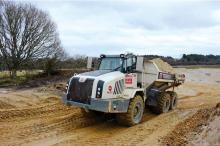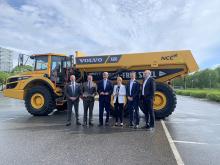
The multi-million euro acquisition of Terex Trucks by Volvo Construction Equipment is big news in the quarrying equipment sector, filling what was a notable gap in Volvo CE’s otherwise extensive equipment range. The company’s boss, Paul Douglas, spoke to Aggregates Business Europe about the likely impact of the major deal.
The completion of the €123.5 million
Based at Terex Trucks key articulated and rigid hauler manufacturing facility in Motherwell, Scotland, the firm’s director and general manager should know a thing or two about all things well-tuned.
“It’s a little-known fact that I used to DJ when I was younger, but that was before I had two sons and two dogs to occupy all my free time. I still enjoy music of all kinds, along with long walks and when the opportunity arises, scuba diving.”
Having joined Terex Trucks in the mid-1980s, and having played a vital role in the company’s growth, Douglas is excited about how
“The objective in the short- to medium-term is to stabilise the business and look for areas where we could benefit from investment and improvement, such as safety, quality, efficiency, and cost. Again, it is still too early post-acquisition to have defined long-term objectives.
“There are plans to update the Motherwell manufacturing facility. With the support of our new parent Volvo CE we have identified areas where investments that modernise and upgrade the facility in terms of safety, environment and quality make sense.”
Demand for new and proven articulated and rigid hauler models within regionals markets is varied, according to Douglas.
“With the articulated haulers especially there is a year-on-year increase in North America, yet many other important markets remain in the doldrums. The year-to-date figures show that demand in Europe remains at a low ebb, with the exception of Germany, which is up. We have a long way to come back so I think it will be a slow recovery. With over half our sales coming from the mining industry – which is currently depressed – demand for our products, especially rigid haulers, will reflect the wellbeing of the wider industry.”
Of the current best-selling Terex branded ADT and RDT models, Douglas added: “The 30tonne articulated hauler is most popular in North America, where they are often used for construction and rental, whereas in other markets, such as Indonesia, they are required for mining projects and owned. In the UK, it is the 40tonne hauler that is most popular. In terms of the rigid haulers, it’s really 50/50 between the 60tonne and 100tonne machines, but the former is most popular for quarry and aggregate projects.”
“Our partner in China, North Hauler Ltd. (NHL) continues to do well, with sales reflecting the health of the Chinese economy, and we will continue to work closely with them as their markets return to levels we had seen previously. The market situation in Russia is more fluid, and we are watching it closely, but the geopolitical situation has dampened sales considerably. Terex Trucks does not have a joint venture in Russia, and there are sound economic reasons to manufacture in Russia due to government importation rules, but for now we will continue to manufacture all trucks in Motherwell.”
Douglas said Terex Trucks-branded haulers with new Tier 4 final/Stage 4 emissions standard engines are entering the North American market, and given their use of a “proven technological solution”, he and other senior Terex Trucks’ figures are confident that customers will welcome what the models have to offer.
At Conexpo 2014 in Las Vegas, Volvo CE president Martin Weissburg said that Volvo CE had the Terex Equipment brand rights for up to and “perhaps beyond” five years, which, Douglas believes, is an important commitment.
“The brand is respected and has a long heritage of providing strong and reliable machines, and that has real value in the global market,” he notes.
R&D spending on Terex Trucks-branded articulated and rigid haulers is set to increase following Volvo CE’s acquisition.
“We now have access to Volvo Construction Equipment’s impressive research and development facilities and competence. For our technology team that opens up exciting opportunities for future product updates,” said Douglas, while, at the same time, stressing that it is “too early to give specifics” on which sized models may be first on the post-acquisition R&D agenda.
Continuing on the R&D theme, Douglas added: “Much of the recent investment in Terex truck R&D has been redesign for legislation compliance, specifically emission-specific engines. Of course it is our intention to invest in future developments of the Terex Trucks products, but the priority for now is to stabilise the business, therefore it is too early to discuss future product plans.”
Having chalked up nearly 30 years at Terex Trucks there is much for Douglas to look back on with pride.
“I started my career in this industry with Terex Trucks in 1985 and I’ve worked my way up. I get the greatest pleasure from seeing other people develop professionally and progress through the business.”
Douglas is keen to encourage young professionals who may be looking to build a successful career in the construction equipment manufacturing sector.
“Think about manufacturing as a career choice. Thirty years ago, 30% of GDP came from manufacturing; it’s now 7%. We need to invest in apprentice and youth engineering programmes. There is a huge opportunity for young people to get involved and to be successful in a manufacturing career, and it’s an extremely exciting and rewarding sector to get into.”









